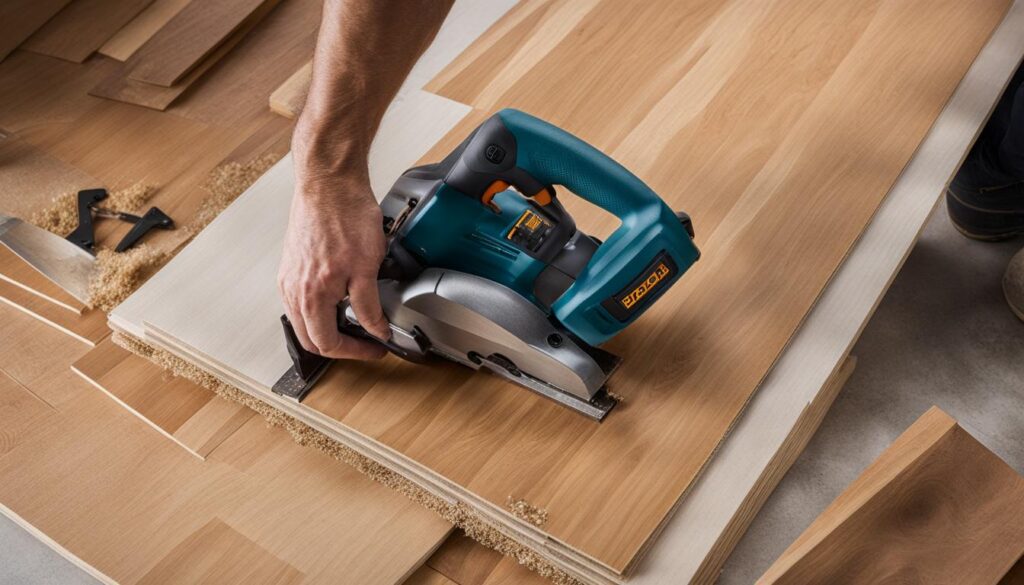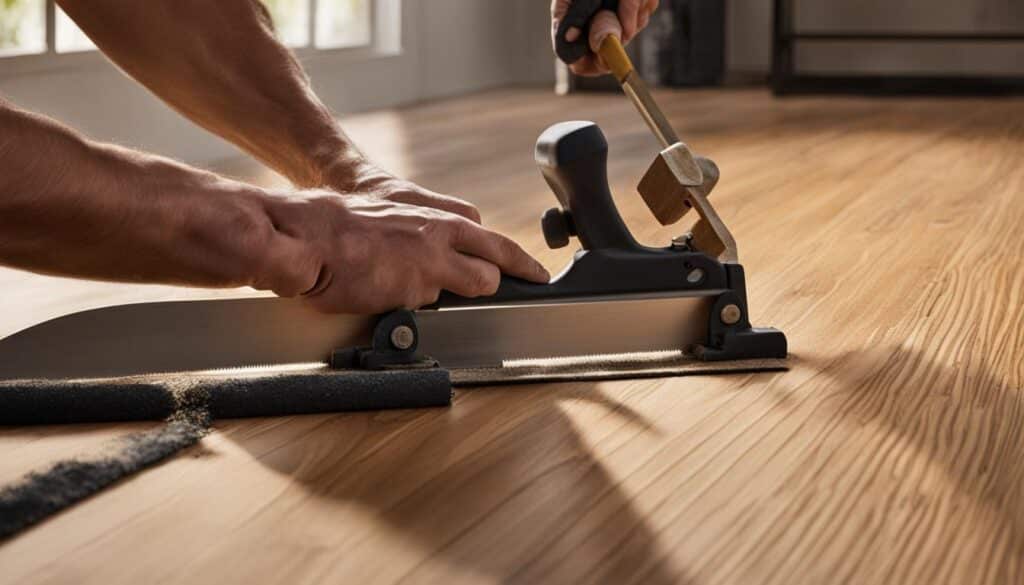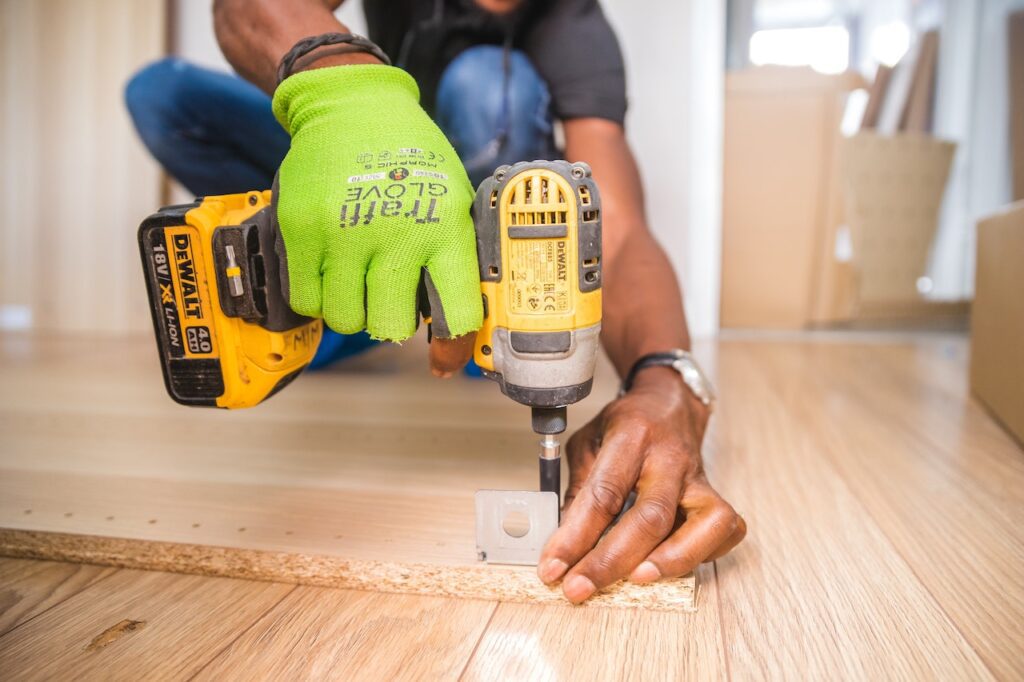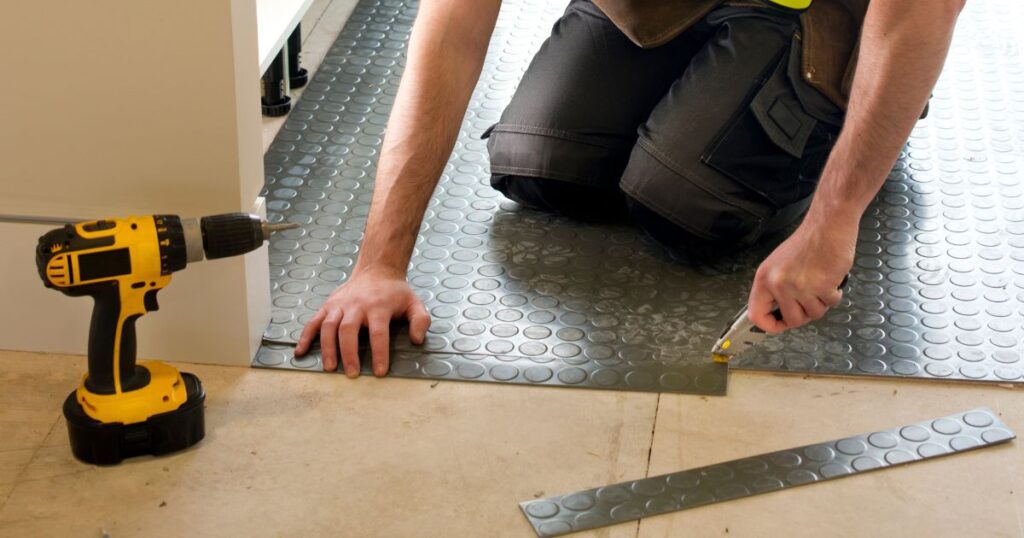In this article, I will share my tips and techniques for cutting laminate flooring without a saw. Whether you’re a DIY enthusiast or simply looking for alternative methods, I’ve got you covered. With these laminate flooring cutting tips, you’ll be able to achieve precise and clean cuts for your home improvement project.
When it comes to laminate flooring, cutting it without a saw can be a challenge. However, with the right techniques and tools, it is possible to achieve professional results. From using a utility knife to employing cutters and shears, there are various options for you to explore. I’ll also discuss when hiring a professional contractor may be the best choice and highlight the benefits of using a pull bar during installation.
Using a Utility Knife
When it comes to cutting laminate flooring without power tools, one of the simplest and most accessible methods is using a utility knife. This versatile tool allows you to score and slice through the laminate with precision, resulting in clean cuts. To achieve the best results, it’s important to use a sharp utility knife blade and regularly replace it when it starts to dull. By applying steady pressure and using a straightedge as a guide, you can create accurate cuts for your laminate flooring.
If you are working with flexible laminate strip material, a Linoleum Knife, which is a type of utility knife, can be particularly useful. The thin, sharp blade of a Linoleum Knife allows for precise cutting, making it an ideal tool for trimming or shaping laminate strips.
Using a utility knife to cut laminate flooring is a great option for those who prefer a low-tech approach or don’t have access to power tools. With a steady hand and a sharp blade, you can achieve professional-looking cuts without the need for a saw.
Cutting Techniques and Tips
When using a utility knife to cut laminate flooring, it’s important to follow some key techniques and tips for optimal results:
- Measure twice and cut once – Take accurate measurements of the area you need to cut, and double-check before making any cuts to avoid costly mistakes.
- Apply consistent pressure – Use steady and even pressure when scoring and slicing the laminate to ensure clean and precise cuts.
- Score multiple times – For thicker laminate, it may be necessary to score the material multiple times before attempting to slice through it. This helps prevent the laminate from splintering or tearing.
- Use a straightedge as a guide – To maintain straight and accurate cuts, use a straightedge as a guide when scoring and slicing the laminate.
- Replace blades regularly – Dull blades can lead to jagged cuts and make the cutting process more difficult. Replace the utility knife blade as soon as it starts to dull for optimal cutting performance.
Using Cutters and Shears
When it comes to cutting laminate flooring without a saw, one effective tool to consider is a laminate floor cutter. This specialized tool is designed to cut laminate floorboards with precision and ease. The cutter utilizes a sharp blade and a long handle, allowing you to apply downward pressure for clean and dust-free cuts.
Laminate floor cutters are user-friendly and produce neat edges, making them a popular choice for DIY enthusiasts. With this tool, you can achieve accurate measurements and create the perfect fit for your flooring installation. It is essential to follow the manufacturer’s instructions and safety guidelines when using a laminate floor cutter to ensure optimal results.
In addition to laminate floor cutters, shears can also be a useful alternative for cutting laminate flooring. Shears are handheld cutting tools that use a scissor-like mechanism to make precise cuts. They are particularly effective for trimming laminate flooring around edges, corners, and tight spaces.
Choosing the Right Cutters and Shears
When selecting cutters and shears for your laminate flooring project, it’s important to consider the thickness and type of laminate you’re working with. Ensure that the tool you choose is suitable for the specific material you are cutting.
For laminate floor cutters, look for ones with adjustable height and angle settings to accommodate different flooring thicknesses and cutting angles. This will ensure precise and clean cuts every time. When it comes to shears, opt for models with sharp blades and ergonomic handles for comfortable and efficient use.
By utilizing cutters and shears, you can achieve professional-looking results in your DIY laminate flooring installation. These tools offer a convenient and efficient way to make accurate cuts without the need for a saw. Take your time, use the proper techniques, and enjoy the satisfaction of completing a successful flooring project.
Hacks for Cutting Laminate Flooring Without a Saw
If you’re looking for alternative methods to cut laminate flooring without a saw, there are a few DIY hacks that can help you achieve accurate results. One handy technique is using a cutter similar to a paper cutter. By applying force on the handle, you can create clean crosscuts with precision. This method requires practice and proper skills, but it can be a cost-effective solution if you don’t have access to power tools.
Another option is using utility knives and scissors for rip or curved cuts. With a sharp utility knife, you can score and slice the laminate flooring, ensuring clean and precise edges. For more intricate cuts, scissors can be used to achieve curved shapes. It’s important to note that these techniques may require more time and effort compared to using a saw, so patience and precision are key.
When attempting to cut laminate flooring without a saw, it’s crucial to prioritize safety. Always wear protective gloves and eye goggles to prevent any accidents or injuries. Additionally, take measurements carefully and double-check before making any cuts to ensure accuracy. By following these hacks and exercising caution, you’ll be able to cut laminate flooring accurately without the need for a saw.
Using a Cutter for Crosscuts
A cutter, similar to a paper cutter, can be a practical tool for creating crosscuts on laminate flooring. By applying force on the handle, you can achieve straight and clean cuts. This method requires a bit of practice to master, but with patience and precision, you can effectively cut laminate flooring without a saw.
Laminate Flooring Cutting Tips: Alternatives to Cutting Laminate Flooring with a Saw
When it comes to cutting laminate flooring without a saw, there are a few alternatives that can yield excellent results. While DIY methods can be effective for simple projects, complex areas like curved rooms or stairwells may require the expertise of a professional contractor. Here are some tips and alternatives to consider for achieving precise cuts without a saw.
Using a Jigsaw
One alternative method for cutting laminate flooring is using a jigsaw. This versatile power tool allows for more intricate cuts, making it ideal for curved or irregular shapes. Ensure you are using a laminate cutting blade for clean and accurate results. Remember to wear safety goggles and work at a steady pace to avoid splintering or chipping the laminate.
Hand Tools: Chisels and Mallets
If you prefer a hands-on approach, using chisels and mallets can be an effective way to cut laminate flooring. Start by scoring the laminate with a utility knife, then carefully tap the chisel along the score line to create a clean cut. This method requires precision and patience, so take your time and make small, controlled movements.
Professional Contractor
For complex projects or if you’re not confident in your DIY skills, hiring a professional contractor is a smart choice. Contractors have the expertise and specialized tools to handle any cutting challenges, ensuring a high-quality installation. They can also provide valuable advice and recommendations based on their experience, ultimately saving you time and potential headaches.

With these alternative methods and tips for cutting laminate flooring without a saw, you can tackle your DIY project with confidence. Whether you opt for a jigsaw, hand tools, or hire a professional contractor, prioritize safety and precision for the best results. Remember to measure and plan carefully, and always follow the manufacturer’s guidelines for your specific laminate flooring product. By taking the time and effort to cut your laminate flooring properly, you can achieve a beautiful and well-installed floor that will last for years to come.
Pull Bar
When it comes to laminate flooring installation, a pull bar can be a handy tool. It is used to carefully pull pieces of laminate together from end to end, ensuring a seamless and secure fit. The pull bar is especially useful in areas where it is challenging to use a mallet and tapping block, such as tight corners or near walls. By placing the hook-shaped end of the pull bar against the end of the laminate floor, you can easily apply pressure and achieve efficient installation.
Using a pull bar is relatively straightforward. Start by inserting the long edge of the pull bar into the groove of the laminate plank and position it against the adjacent plank. Then, using a hammer or mallet, gently tap on the pull bar to create a tight connection between the two planks. Repeat this process for each subsequent plank until the entire row is securely locked in place.
Benefits of Using a Pull Bar
Using a pull bar offers several advantages in laminate flooring installation. Firstly, it allows for precise control and alignment of the planks, ensuring a professional-looking finish. The pulling action helps to eliminate gaps between the planks, preventing any potential damage or movement over time. Additionally, using a pull bar reduces the likelihood of damaging the edges of the planks, as it evenly distributes the force applied during installation.
Overall, a pull bar is an essential tool for DIY enthusiasts and professional installers alike. Its ease of use and effectiveness make it a popular choice for achieving smooth and secure laminate flooring installation. By incorporating a pull bar into your toolkit, you can ensure a successful and visually appealing flooring project.

Conclusion
When it comes to laminate flooring installation, there are several tips and hacks that can help you cut laminate flooring without a saw. Whether you choose to use a utility knife, cutters and shears, or hire a professional contractor, it’s important to consider the specific requirements of your project.
Start by measuring the size and span of the room, ensuring you have the correct dimensions for your laminate flooring. If you opt for alternative cutting tools, such as a utility knife or laminate floor cutter, make sure to follow the manufacturer’s instructions and prioritize safety. Safety goggles and gloves are recommended when working with sharp tools.
If you’re comfortable with a hands-on approach, consider using a cutter or utility knife for crosscuts or rip cuts. With practice and precision, you can achieve accurate and neat cuts. However, for complex projects or challenging areas like curved rooms or stairwells, it may be best to hire a professional contractor. They have the necessary expertise and tools to handle the cutting process efficiently, ensuring high-quality results.
Remember, no matter which method you choose, always prioritize safety and precision. Cutting laminate flooring without a saw may seem daunting at first, but with the right techniques, you can successfully install a beautiful and well-cut floor. Happy DIY-ing!
FAQ
Can I cut laminate flooring without a saw?
Yes, there are alternative methods for cutting laminate flooring without using a saw.
What tools can I use to cut laminate flooring without a saw?
You can use a utility knife, a laminate floor cutter, or DIY methods such as using cutters and shears.
How do I cut laminate flooring with a utility knife?
By scoring and slicing the laminate with a sharp utility knife blade, you can achieve clean cuts.
What is a laminate floor cutter and how does it work?
A laminate floor cutter is a specialized tool that uses a sharp blade and a long handle to apply downward pressure, resulting in clean and dust-free cuts.
Are there any DIY methods for cutting laminate flooring?
Yes, you can try using a cutter, utility knives, and scissors to achieve different types of cuts, such as crosscuts or rip and curved cuts.
Should I hire a professional contractor for cutting laminate flooring?
Hiring a professional contractor is recommended for complex projects or challenging areas like curved rooms or stairwells, as they have the necessary tools and expertise to handle the cutting process efficiently.
What is a pull bar and how can it help with laminate flooring installation?
A pull bar is a tool used to carefully pull pieces of laminate together from end to end, particularly in areas where it is challenging to use a mallet and tapping block. It aids in easy and efficient installation.
Can I achieve accurate cuts without a saw?
Yes, with the right approach and techniques, you can achieve accurate and neat cuts when cutting laminate flooring without a saw.
What should I consider when cutting laminate flooring without a saw?
It is important to consider the specific requirements of your project, measure the size and span of the room, opt for alternative cutting tools if necessary, and prioritize safety and precision.





